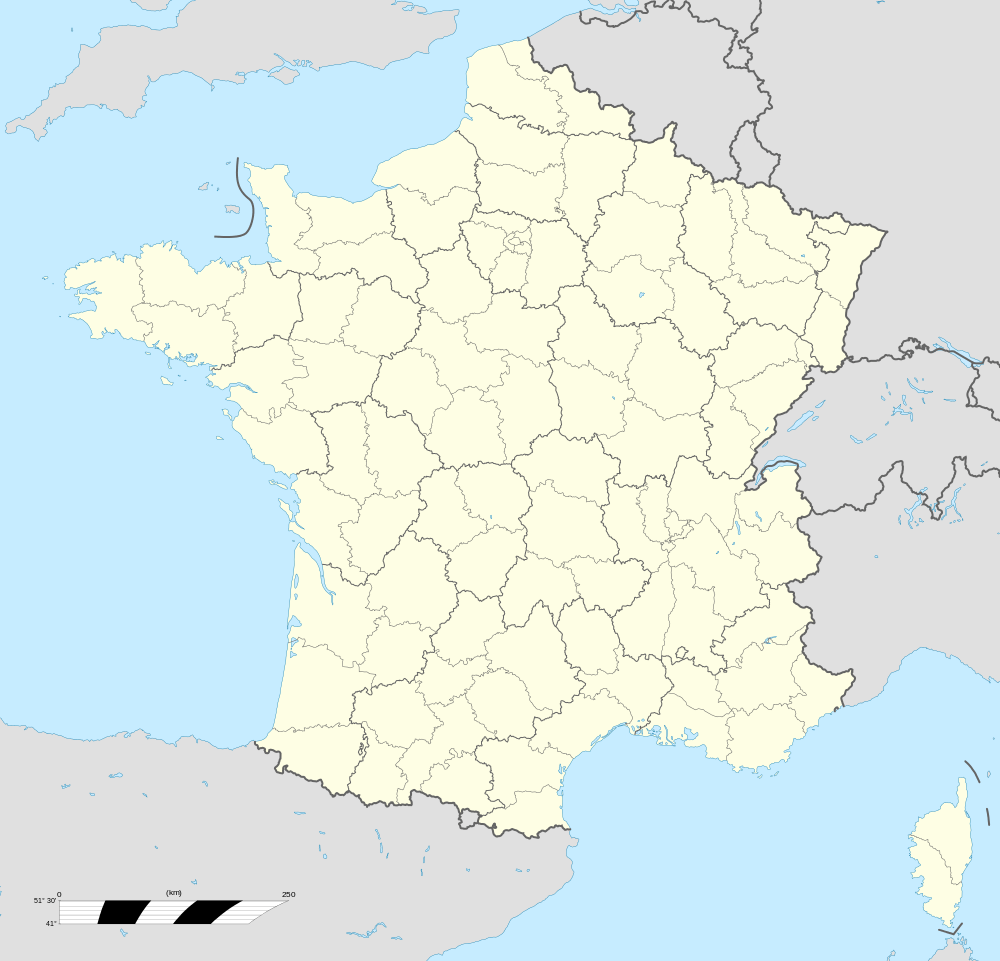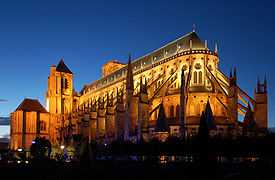Bourges
| Bourges | |||
|---|---|---|---|
|
| |||
| |||
 Bourges | |||
|
Location within Centre region  Bourges | |||
| Coordinates: 47°05′04″N 2°23′47″E / 47.0844°N 2.3964°ECoordinates: 47°05′04″N 2°23′47″E / 47.0844°N 2.3964°E | |||
| Country | France | ||
| Region | Centre-Val de Loire | ||
| Department | Cher | ||
| Arrondissement | Bourges | ||
| Intercommunality | Bourges | ||
| Government | |||
| • Mayor (2014–2020) | Pascal Blanc | ||
| Area1 | 68.74 km2 (26.54 sq mi) | ||
| Population (2009)2 | 66,786 | ||
| • Density | 970/km2 (2,500/sq mi) | ||
| INSEE/Postal code | 18033 / 18000 | ||
| Elevation |
120–169 m (394–554 ft) (avg. 153 m or 502 ft) | ||
|
1 French Land Register data, which excludes lakes, ponds, glaciers > 1 km² (0.386 sq mi or 247 acres) and river estuaries. 2 Population without double counting: residents of multiple communes (e.g., students and military personnel) only counted once. | |||
| Historical population | ||
|---|---|---|
| Year | Pop. | ±% |
| 1793 | 15,964 | — |
| 1800 | 16,330 | +2.3% |
| 1806 | 17,552 | +7.5% |
| 1821 | 18,910 | +7.7% |
| 1831 | 19,730 | +4.3% |
| 1836 | 25,324 | +28.4% |
| 1841 | 22,826 | −9.9% |
| 1846 | 24,799 | +8.6% |
| 1851 | 25,037 | +1.0% |
| 1856 | 26,799 | +7.0% |
| 1861 | 28,064 | +4.7% |
| 1866 | 30,119 | +7.3% |
| 1872 | 31,312 | +4.0% |
| 1876 | 35,785 | +14.3% |
| 1881 | 40,217 | +12.4% |
| 1886 | 42,829 | +6.5% |
| 1891 | 45,342 | +5.9% |
| 1896 | 43,587 | −3.9% |
| 1901 | 46,551 | +6.8% |
| 1906 | 44,133 | −5.2% |
| 1911 | 45,735 | +3.6% |
| 1921 | 45,942 | +0.5% |
| 1926 | 44,245 | −3.7% |
| 1931 | 45,067 | +1.9% |
| 1936 | 49,263 | +9.3% |
| 1946 | 51,040 | +3.6% |
| 1954 | 53,879 | +5.6% |
| 1962 | 60,632 | +12.5% |
| 1968 | 70,814 | +16.8% |
| 1975 | 77,300 | +9.2% |
| 1982 | 76,432 | −1.1% |
| 1990 | 75,609 | −1.1% |
| 1999 | 72,434 | −4.2% |
| 2008 | 68,980 | −4.8% |
Bourges (French pronunciation: [buʁʒ]) is a city in central France on the Yèvre river. It is the capital of the department of Cher and also was the capital of the former province of Berry.
History
The name of the city derives either from the Bituriges, the name of the original inhabitants, or from the Germanic Burg (French: Bourg. Spanish: Burgos. English, others: Burgh, Berg, or Borough), for "hill/village". The Celts called it Avaricon; Latin-speakers: Avaricum.
In the Gallic Wars of 58-50 BC the Gauls practised a scorched earth policy, but the inhabitants of Avaricum begged not to have their city burned, and it was spared due to its good defences provided by the surrounding marshes and a strong southern wall. Following the siege of Avaricum in the winter of 52 BC, Julius Caesar's forces destroyed the city and killed all but 800 of its inhabitants.
Rome reconstructed Avaricum as a Roman city, with a monumental gate, aqueducts, thermae and an amphitheatre, reaching a greater size than it would attain during the Middle Ages. The massive walls surrounding the late Roman city, enclosing 40 hectares, were built in part with stone re-used from earlier public buildings.
The third-century AD Saint Ursinus, also known as Saint Ursin, is considered the first bishop of the city. Bourges is the seat of an archbishopric. During the 8th century Bourges lay on the northern fringes of the Duchy of Aquitaine and was therefore the first town to come under Frankish attacks when the Franks crossed the Loire. The Frankish Charles Martel captured the town in 731, but Duke Odo the Great of Aquitaine immediately re-took it. It remained under the rule of counts who pledged allegiance to the Aquitanian dukes up to the destructive assault by Pepin the Short on independent Aquitaine starting in 760, when Basque troops are found defending the town along with its count.
The Gothic Cathedral of Saint Etienne, begun at the end of the twelfth century, ranks as a World Heritage Site. It is considered the earliest example of the High Gothic style of the thirteenth century.
During the Middle Ages, Bourges served as the capital of the Viscounty of Bourges until 1101. In the fourteenth century it became the capital of the Duchy of Berry. The future king of France, Charles VII (reigned 1422-1461), sought refuge there in the 1420s during the Hundred Years' War. His son, Louis XI, was born there in 1423. In 1438, Charles VII decreed the Pragmatic Sanction of Bourges. During this period, Bourges was also a major capital of alchemy.
The city has a long tradition of art and history. Apart from the cathedral, other sites of importance include the 15th-century Palace of Jacques Cœur and a sixty-five-hectare district of half-timbered houses and fine town-houses.
Sights

- Its Gothic cathedral (built 1195–1255) was added to the list of the World Heritage Sites by UNESCO in 1992
- Jacques Cœur's palace[1]
- Lallemant's hotel, from the early French Renaissance[2]
- The Berry museum, located in the Cujas' hotel[3]
- The Estève museum, located in the so-called aldermen's hotel[4]
- The marshes of the Yèvre and Voiselle rivers were listed in 2003 as a French Natural Monument or Site[5]
- The ruins of the Gallo-Roman walls
- The Conservatoire national du Pélargonium
Transport
The railway station Gare de Bourges offers direct connections to Paris (2 hours), Orléans, Tours, Lyon and several regional destinations. The A71 motorway connects Bourges with Orléans and Clermont-Ferrand. Bourges Airport is a small regional airport.
Sport and recreation
Bourges' principal football team are Bourges Football 18. It is also home to the women's basketball club CJM Bourges Basket, which has won multiple titles in domestic and European basketball. Bourges XV is the premier rugby team in the region, currently playing in French National Division, Federal 3.
Colleges and universities
- University of Bourges
- École des Beaux Arts ()
- Ecole Nationale Supérieure d'Ingénieurs ENSI ()
Twin towns
Bourges is twinned with:

 Augsburg, Germany
Augsburg, Germany Aveiro, Portugal
Aveiro, Portugal Forlì, Italy
Forlì, Italy Koszalin, Poland
Koszalin, Poland Palencia, Spain
Palencia, Spain Peterborough, United Kingdom[6][7]
Peterborough, United Kingdom[6][7] Yoshkar-Ola, Russia
Yoshkar-Ola, Russia
Events
The Printemps de Bourges music festival takes place in Bourges every year.
Every summer, and since 2002, « les milles univers » hosts a writing workshop in collaboration with Oulipo.[8]
Personalities
The merchant Jacques Cœur was born in Bourges.
John Calvin was a student in the University of Bourges.
The legal expert Jacques Cujas lived in Bourges during 1555-1557 and 1575-1590.
The Impressionist painter Berthe Morisot was born in Bourges on 14 January 1841.
The Art Nouveau sculptor Julien Caussé was born in Bourges in 1869.
The philosopher Vladimir Jankélévitch was born on 31 August 1903, in Bourges.
Emmanuel Imorou, footballer.
See also
References
- ↑ Jacques Cœur's palace, visitor centre
- ↑ Lallemant's hotel, visitor centre
- ↑ Berry museum, visitor center
- ↑ Estève museum, visitor centre
- ↑ Bourges' marshes, visitor centre
- ↑ "British towns twinned with French towns". Archant Community Media Ltd. Retrieved 2013-07-11.
- ↑ Town Twinning –International Links Peterborough City Council (Retrieved 24 April 2007).
- ↑ Les récréations à Bourges.
External links
| Wikimedia Commons has media related to Bourges. |
- Official website
- Bourges, the departement of Cher (French and English)
| ||||||


